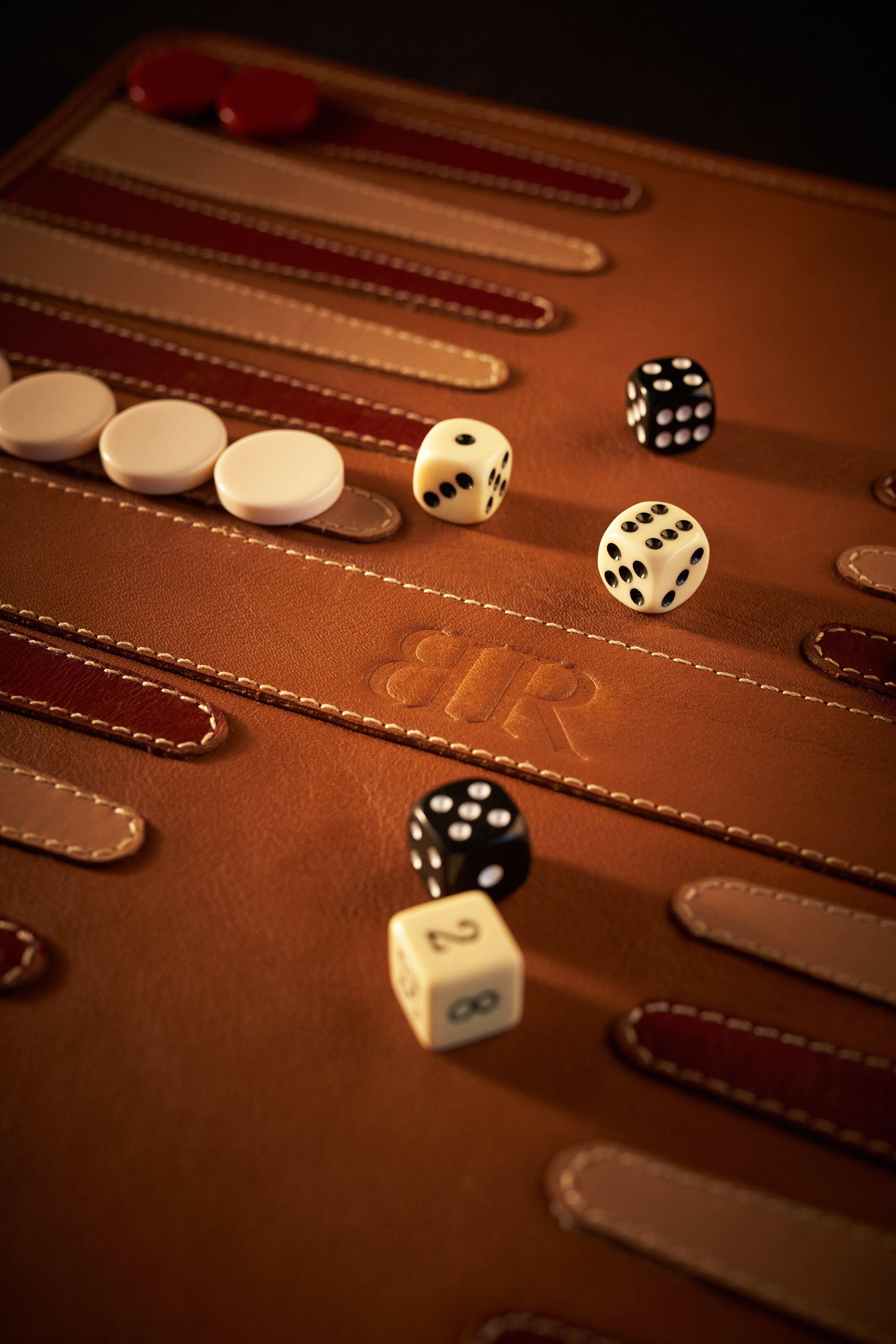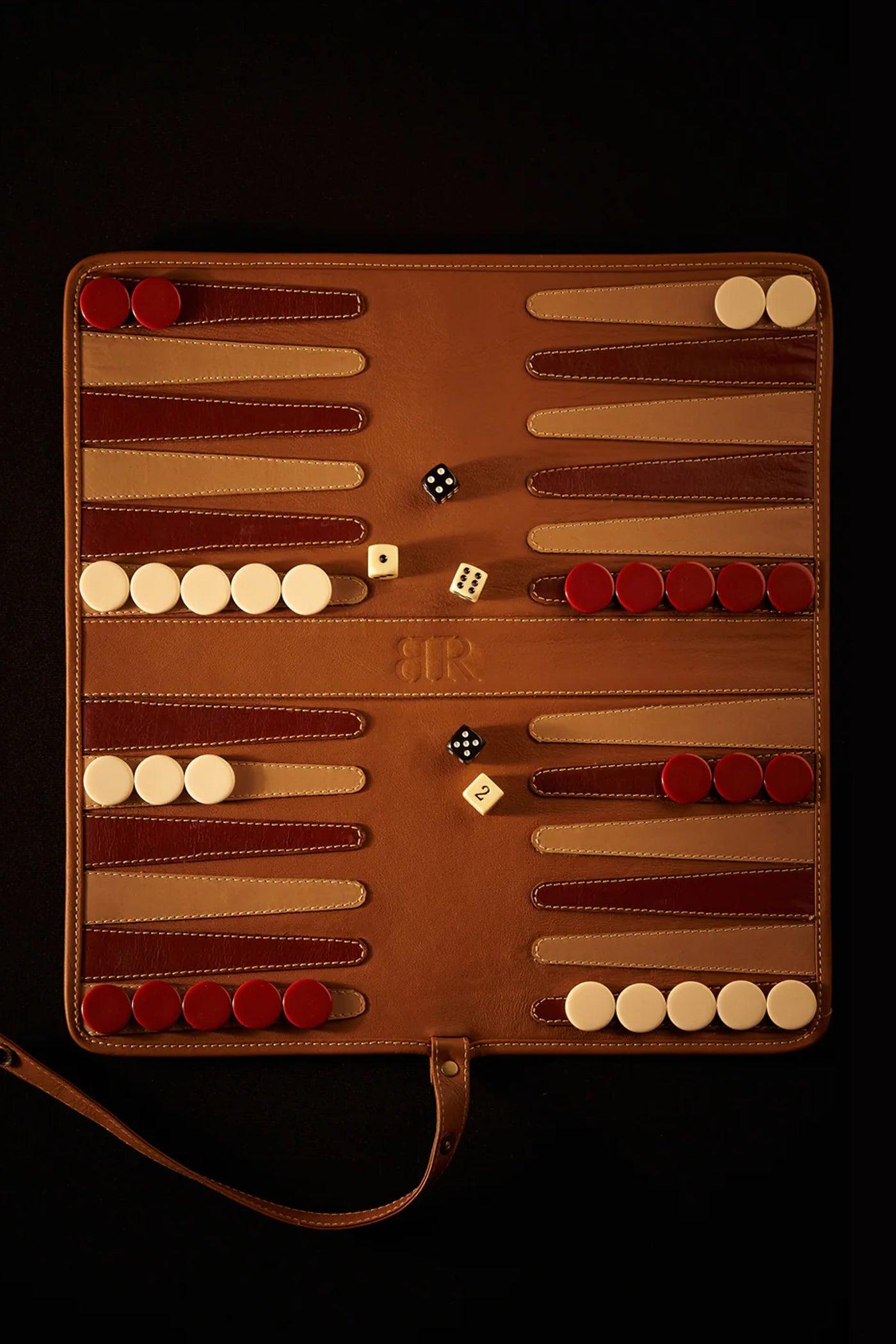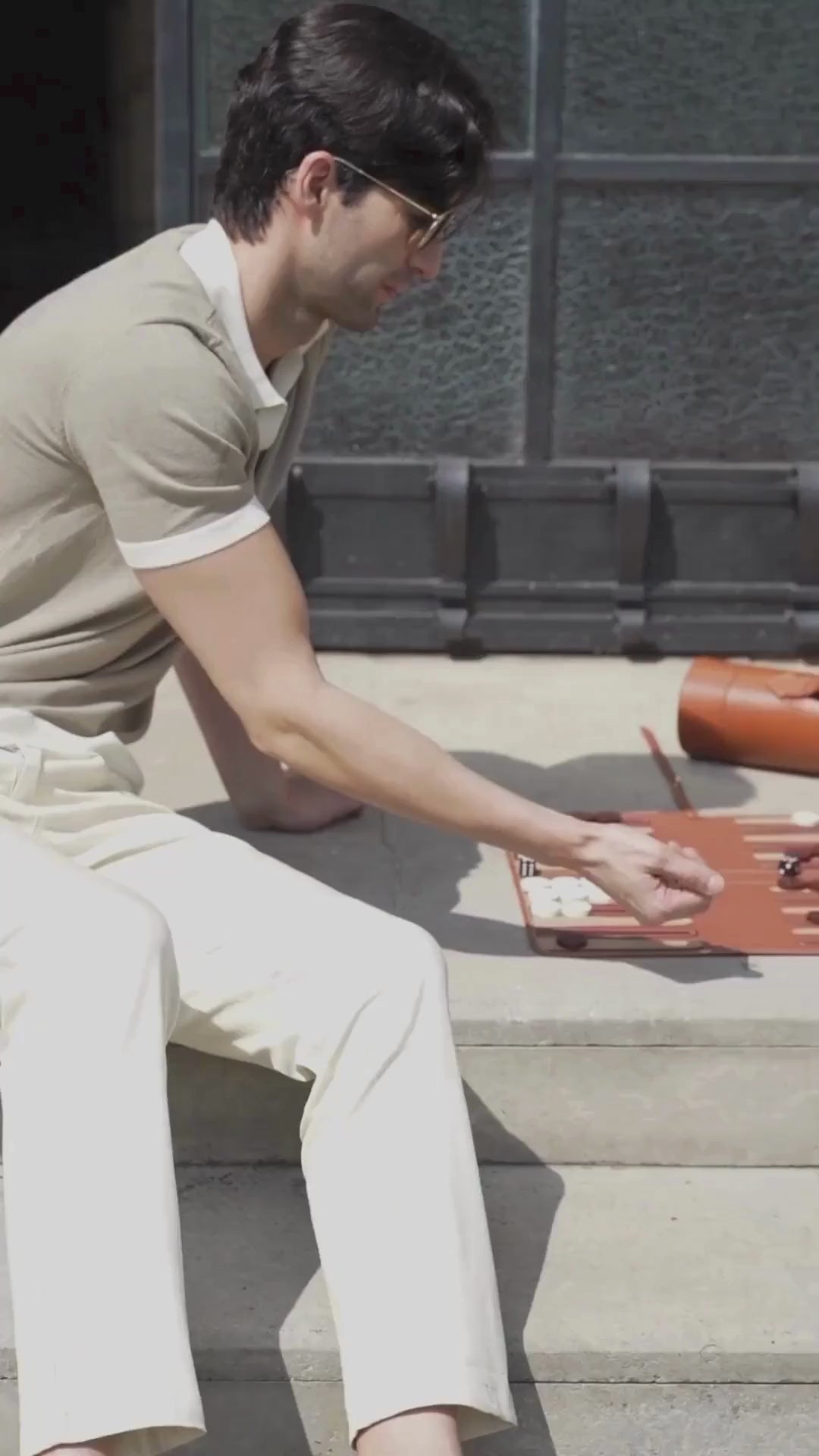The rules of Backgammon.
SET UP
Backgammon is a game for two players, played on a board made up of twenty-four narrow triangles called points. The triangles alternate in color and are grouped into four quadrants of six triangles each. The quadrants are called the inner quadrant and the outer quadrant. The quadrants are separated from each other by a bar in the center of the board.

Figure 1. A board with the checkers in their initial position. An alternative arrangement is the reverse of that shown here, with the home board on the left and the outer board on the right.
The points are numbered for any player starting on that player's home board. The outermost point is twenty-four, which is also the opponent's point one. Each player has fifteen checkers of his own color. The initial arrangement of checkers is: two on each player's twenty-fourth point, five on each player's thirteenth point, three on each player's eighth point, and five on each player's sixth point.
Both players have their own pair of dice. A doubling die, with the numbers 2, 4, 8, 8, 16, 32 and 64 on its faces, is used to keep track of the current stake of the game.
GAME OBJECTIVE
The object of the game is to move all your checkers to your own board and then remove them. The first player to remove all his checkers wins the game.

Figure 2. Direction of movement of the white checkers. The red checkers move in the opposite direction.
MOVEMENT OF THE CHECKERS
To start the game, each player rolls a single die. This determines which player will go first as well as the numbers to be played. If the same numbers come up, both players roll again until different numbers are rolled. The player who rolls the higher number now moves his checkers according to the numbers on both dice. After the first roll, the players roll two dice and alternate turns.
The roll of the dice indicates how many points the player must move his checkers. The checkers always move forward to a lower numbered point.
The following rules apply:
1. A checker can only move to an open point, one that is not occupied by two or more opposing checkers.
2. The numbers on the two dice constitute separate moves. For example, if a player rolls 5 and 3, he can move one checker five spaces to an open point and another checker three spaces to an open point, or he can move the one checker a total of eight spaces to an open point, but only if the intervening point (either three or five spaces from the starting point) is also open.
 Figure 3. Two ways White can play a roll of 5 and 3.
Figure 3. Two ways White can play a roll of 5 and 3.
3. A player who rolls doubles plays the numbers shown on the dice twice. A roll of 6 and 6 means that the player has four sixes to use, and may move any combination of checkers he deems appropriate to complete this requirement.
4. A player must use both numbers of a roll if this is legally possible (or all four numbers of a double). When only one number can be played, the player must play that number. Or if either number can be played, but not both, the player must play the higher number. When neither of the two numbers can be used, the player loses his turn. In the case of doubles, when all four numbers cannot be played, the player must play as many numbers as he/she can.
ATTACK & ENTER
A point occupied by a single checker of any color is called a blot. If an opposing checker lands on a blot, the blot is attacked and placed on the bar.
Whenever a player has one or more checkers on the bar, his first obligation is to enter that checker(s) into the opposing team's board. A checker is introduced by moving it to an open spot corresponding to one of the numbers on the dice rolled.
For example, if a player rolls a 4 and a 6, he may place a checker on the opponent's point four or point six, provided that the intended point is not occupied by two or more of the opponent's checkers.

Figure 4. If the white player draws 6 and 4 with a checker on the bar, he must place the checker on red point four, since red point six is not open.
If none of the points is open, the player loses his turn. If a player can enter some of his checkers, but not all of them, he must enter as many as he can and loses the rest of his turn.
Once a player's last checker has been entered, the unused numbers on the dice must be played, moving the checker that was entered or a different checker.
MOVEMENT TO REMOVE THE CHECKERS FROM THE BOARD
Once a player has moved all of his fifteen checkers to his board, he may begin to remove them. A player removes a checker by drawing a number that corresponds to the point on which the checker is located, and then removing that checker from the board. Thus, rolling a 6 allows the player to remove a checker from point six.
If there is no checker on the point indicated by the roll, the player must make a legal move using a checker on a higher numbered point. If there are no checkers on higher numbered points, the player is authorized (and obligated) to remove a checker from the highest point on which one of his checkers is located. A player is not obliged to remove a checker if he can make a legal move.

Figure 5. White rolls 6 and 4 and draws two checkers.
A player must have all his active pieces on his home board to be able to retreat. If a checker is attacked during the retreat process, the player must return it to his home board before continuing with the retreat. The first player to remove all fifteen checkers wins the game.
DOUBLING
Backgammon is played for an agreed stake per point. Each game starts with one point. During the course of the game, a player who considers that he has sufficient advantage may propose to double the stake. He may do so only at the beginning of his own turn and before the dice have been rolled.
A player who is offered to double the bet may refuse, in which case he/she concedes the game and pays one point. Otherwise, he must accept the double and continue playing for the new higher bet. The player who accepts a double becomes the owner of the die, and only he can make the next double.
Subsequent doubles in the same game are called re-doubles. If a player rejects a re-double, he must pay the number of points that were in play before the re-double. Otherwise, he becomes the new owner of the dice and the game continues with double the previous bets. There is no limit to the number of re-doubles in a game.
GAMMONS & BACKGAMMONS
At the end of the game, if the losing player has drawn at least one checker, he loses only the value shown on the doubling die (one point, if there were no doubles). However, if the loser has not drawn any of his checkers, he is expelled and loses double the value of the doubling die. Or, even worse, if the loser has not removed any of his checkers and still has a checker on the bar or on the winner's board, he is kicked out and loses triple the value of the doubling die.
OPTIONAL RULES
The following optional rules are in general use:
1. Automatic doubles. If identical numbers are rolled on the first roll, the bets are doubled. The doubling die is set to 2 and remains in the center. Players usually agree to limit the number of automatic doubles to one per game.
2. Beavers. When a player is doubled, he may immediately redouble (beaver) while retaining possession of the die. The original doubler has the option to accept or reject as in the case of a normal double.
3. Jacoby's rule. Gammons and backgammons only count as a single game if no player has offered a double during the course of the game. This rule speeds up the game by eliminating situations where a player avoids doubling in order to continue playing for a gammon.
IRREGULARITIES
1. The dice must be rolled together and land flat on the surface of the right section of the board. The player must reroll both dice if a die lands outside the right-hand board, or lands on a checker, or does not land flat.
2. A turn is completed when the player collects his dice. If the move is incomplete or illegal, the opponent has the option of accepting the move as made or of requiring the player to make a legal move. A move is considered to have been accepted as made when the opponent rolls his dice or offers a double to start his own turn.
3. If a player rolls before his opponent has completed his turn by picking up the dice, the player's roll is void. Generally, this rule is nullified whenever a move is forced or when there is no more contact between the opposing forces.















